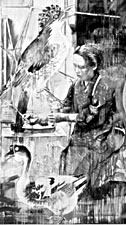|

Comment
on this story
What:
Beyond the Frame: Hung Liu and Whitfield Lovell
Where:
The Knoxville Museum of Art, 1050 World's Fair Park Drive
When:
through Dec. 16. Call 525-6101 for information
|
|

Artists Hung Liu and Whitfield Lovell grapple with personal history
by Heather Joyner
One could call the '80s and '90s corrective decades in which previously unacknowledged artists gained deserved recognition. Minority and "post-colonial" art has since been dominant, and a number of individuals with run-of-the-mill white "American" ancestry or otherwise privileged experiences have been shoved into a closet, their concerns no longer considered relevant or interesting. It has to be somebody's turn to go ignored, after all. But many artists now in the spotlight seem embarrassed to make straightforward race- and gender-related artistic statements.
I might catch hell for the following, but I'll say it anyway: I'm tired of art that denies where it's coming from—which doesn't mean that a woman (for instance) should produce creative work about being a woman or being a woman of specific ethnicity. Black author Zora Neale Hurston was dismissed for writing outside "the protest tradition," but her fiction still shines. I am instead referring to pieces that employ inherently symbolic elements without accepting responsibility for them.
Artists certainly have a right to determine their means of expression. However, when Whitfield Lovell incorporates chains and animal traps into a portrait of an African American man and then asserts that slavery and subjugation "do not inform [its] creation," I feel manipulated. If one is going to milk one's legacy, why hide the cow? What's wrong with the intentional use of a cow if you have one? Currently exhibited at the KMA, Lovell is as undeniably talented as Hung Liu, the artist he's been paired with. Both have clearly mastered their media and present memorable work. Yet each leans more toward process than content, despite the insistence—albeit muffled—of their respective subject matter. The result of their depriving themselves is that we also end up deprived.
The space occupied by the KMA's Beyond The Frame series of shows seems a bit somber these days. Although the subdued lighting and gray walls have something to do with it, it can as easily be attributed to the artistic hesitance mentioned above. Lovell's assembled found wood planks serving as backdrops for his "tableaux" might project warmth if they weren't bruised and discarded-looking. Implying that the people sketched on them have likewise been abandoned—if only due to the passage of time—they resemble rafts as well as siding for shacks.
Lovell was initially inspired by family photographs but lately utilizes pictures of long-dead strangers to create tight charcoal drawings, saying they permit him to "more freely associate ideas and images." Combined with objects like old flags (in "America"), whiskey-stained jiggers (in "Bliss"), and crates of pennies (in "Having"), they suggest stories we may not understand but find intriguing anyway. It's when "open-to-interpretation" feels too much like "cautiously ambiguous" that I become frustrated. Especially considering the sheer beauty of pieces like "Brethren" and "Psalm II" (featuring an intimately-rendered female face above an open Bible).
Liu's work, primarily oil paint on large canvases, has the spontaneity and appeal of abstract expressionism. Despite her representational and almost photo-realist thrust, the many drips and shifts in scale are clearly linked to artists like Willem de Kooning. Born in Changchun, China, in 1948 (11 years before the birth of Lovell in the Bronx), Liu has been subjected to much political chaos and repression. Painting in a modern manner, she nevertheless herein shies away from bolder references to her experience. "Boxer Rebellion" has the most blatant message, and it's gorgeous, besides. Three paintings from photographs of decapitated Chinese hang above projecting red birdcages that allude to where such heads were placed to warn turn-of-the-century upstarts. However, "Boxer Rebellion" is about an event more safely in the past than Mao's Cultural Revolution of the '60s, during which Liu was yanked out of school to be "re-educated" as a farm laborer.
A portrait of the late Qing Dynasty Empress Tzu-Hsi shows a small and harmless-looking woman enthroned beneath a banner celebrating the longevity of her reign. Known as "the Dragon Lady," the Empress appears benign except for a tiny claw-like hand. As detailed as the painting is, Liu conveys little in terms of emotion. Why paint the Empress? What does she mean to the artist or to us? Beats me. But I must credit Liu with producing work that avoids a predictable "Asian feel."
Nineteen ninety-nine's "Rice Culture I" presents a Malaysian woman amidst birds, water, and ancient Tibetan Buddhist images of angels. The whole whirlwind effect in glorious and unusual color perhaps refers to the insignificance of one's earthly existence given the concept of transcendence. Liu implies that as part of nature, we are inevitably distracted by the struggle to survive. No matter what political message viewers find in it, "Rice Culture II" does not suffer from an inability to address social conflict.
Whatever its shortcomings, the work of both Liu and Lovell possess many strengths and deserve notice. I look forward to seeing what comes next.

November 15, 2001 * Vol. 11, No. 46
© 2001 Metro Pulse
|